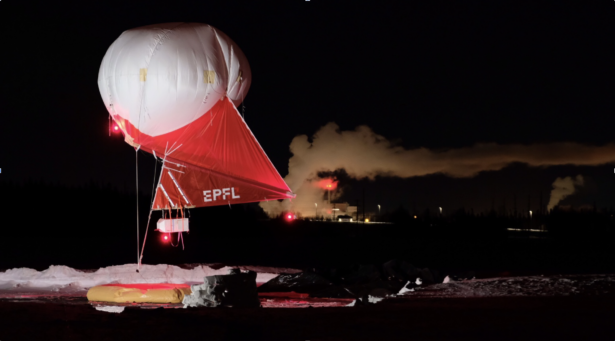There has been talk about spotting a UFO in Fairbanks, but we are here to break the myth. A team of researchers from the Swiss Federal Institute of Technology (EPFL), in collaboration with institutes from France and Italy, have been conducting experiments using this balloon as a part of the ongoing ALPACA campaign.
The research balloon, also known as a ‘HeliKite’, is a platform for studying gasses and particles in the air. It is filled with helium gas and flies up to 200 feet during daytime and 1200 feet during nighttime. It aims to study how pollution is distributed in different layers of the air. Fairbanks experiences very strong temperature inversions due to its cold weather, making it an ideal place to study air pollution episodes. In the last six weeks of the campaign, the team has flown the balloon more than 20 times. The flight date largely depends on weather conditions such as temperature, precipitation, and wind speed and direction. In addition to the vertical measurements, ground-based instruments provide validation and a long-term context for the airborne data. These instruments include in-situ measurements of air pollution and also remote sensing instruments to characterize the vertical structure of the atmosphere. Remote sensing of the wind and how it varies with altitude is done using a laser instrument called a LIDAR, which makes these measurements continuously.
The group has successfully sampled different types of vertical air conditions, ranging from very shallow polluted inversions to cleaner air. The scientists hope to characterize the sources of pollution and understand how mixing happens based on changing weather conditions. This is the first time such comprehensive measurements are being conducted in a sub-Arctic urban region. The results not only give answers about air quality but also about how the rapidly warming climate in sub-polar regions affects pollution and vertical mixing. Stay tuned for exciting results!
Groups involved in this study include the Extreme Environments Research Laboratory at Ecole Polytechnique Federale de Lausanne (EPFL), Switzerland; LAERO, Observatoire Midi-pyrénénées, Université de Toulouse III/CNRS, Toulouse, France; CNR, Italy; LATMOS, France and College of Natural Science and Mathematics. University of Alaska Fairbanks.
-Article by Sukriti Kapur, Graduate student, UCI


